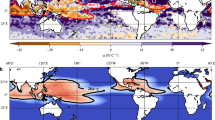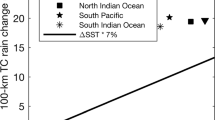Abstract
Tropical convection is an important factor in regional climate variability and change around the globe 1,2. The response of regional precipitation to global warming is spatially variable, and state-of-the-art model projections suffer large uncertainties in the geographic distribution of precipitation changes 3,4,5. Two views exist regarding tropical rainfall change: one predicts increased rainfall in presently rainy regions (wet-get-wetter) 6,7,8, and the other suggests increased rainfall where the rise in sea surface temperature exceeds the mean surface warming in the tropics (warmer-get-wetter)9,10,11,12. Here we analyse simulations with 18 models from the Coupled Model Intercomparison Project (CMIP5), and present a unifying view for seasonal rainfall change. We find that the pattern of ocean warming induces ascending atmospheric flow at the Equator and subsidence on the flanks, anchoring a band of annual mean rainfall increase near the Equator that reflects the warmer-get-wetter view. However, this climatological ascending motion marches back and forth across the Equator with the Sun, pumping moisture upwards from the boundary layer and causing seasonal rainfall anomalies to follow a wet-get-wetter pattern. The seasonal mean rainfall, which is the sum of the annual mean and seasonal anomalies, thus combines the wet-get-wetter and warmer-get-wetter trends. Given that precipitation climatology is well observed whereas the pattern of ocean surface warming is poorly constrained 13,14, our results suggest that projections of tropical seasonal mean rainfall are more reliable than the annual mean.
This is a preview of subscription content, access via your institution
Access options
Subscribe to this journal
Receive 12 print issues and online access
$259.00 per year
only $21.58 per issue
Buy this article
- Purchase on Springer Link
- Instant access to full article PDF
Prices may be subject to local taxes which are calculated during checkout




Similar content being viewed by others
References
Alexander, M. A. et al. The atmospheric bridge: The influence of ENSO teleconnections on air–sea interaction over the global oceans. J. Clim. 15, 2205–2231 (2002).
Shin, S-I. & Sardeshmukh, P. D. Critical influence of the pattern of Tropical Ocean warming on remote climate trends. Clim. Dyn. 36, 1577–1591 (2011).
Meehl, G. A. et al. in Climate Change 2007: The Physical Science Basis (eds Solomon, S. et al.) Ch. 10, 747–845 (Global Climate Projections, Cambridge Univ. Press, 2007).
Zhang, X. et al. Detection of human influence on twentieth-century precipitation trends. Nature 448, 461–465 (2007).
Ma, J. & Xie, S-P. Regional patterns of sea surface temperature change: A source of uncertainty in future projections of precipitation and atmospheric circulation. J. Clim.http://dx.doi.org/10.1175/JCLI-D-1112-00283.00281 (in the press, 2013).
Neelin, J., Chou, C. & Su, H. Tropical drought regions in global warming and El Nino teleconnections. Geophys. Res. Lett. 30, 2275 (2003).
Held, I. M. & Soden, B. J. Robust responses of the hydrological cycle to global warming. J. Clim. 19, 5686–5699 (2006).
Chou, C., Neelin, J., Chen, C. & Tu, J. Evaluating the ‘rich-get-richer’ mechanism in tropical precipitation change under global warming. J. Clim. 22, 1982–2005 (2009).
Xie, S-P. et al. Global warming pattern formation: Sea surface temperature and rainfall. J. Clim. 23, 966–986 (2010).
Johnson, N. C. & Xie, S-P. Changes in the sea surface temperature threshold for tropical convection. Nature Geosci. 3, 842–845 (2010).
Sobel, A. H. & Camargo, S. J. Projected future seasonal changes in tropical summer climate. J. Clim. 24, 473–487 (2011).
Chadwick, R., Boutle, I. & Martin, G. Spatial patterns of precipitation change in CMIP5: Why the rich don’t get richer in the tropics. J. Clim.http://dx.doi.org/10.1175/JCLI-D-1112-00543.00541 (in the press, 2013).
Tokinaga, H., Xie, S. P., Deser, C., Kosaka, Y. & Okumura, Y. M. Slowdown of the Walker circulation driven by tropical Indo-Pacific warming. Nature 491, 439–443 (2012).
Vecchi, G. & Soden, B. Global warming and the weakening of the tropical circulation. J. Clim. 20, 4316–4340 (2007).
Vecchi, G. A. & Soden, B. J. Effect of remote sea surface temperature change on tropical cyclone potential intensity. Nature 450, 1066–1070 (2007).
Taylor, K. E., Stouffer, R. J. & Meehl, G. A. An overview of CMIP5 and the experiment design. Bull. Am. Meteorol. Soc. 93, 485–498 (2012).
Chou, C. & Tu, J. Y. Hemispherical asymmetry of tropical precipitation in ECHAM5/MPI-OM during El Niño and under global warming. J. Clim. 21, 1309–1332 (2008).
Tan, P-H., Chou, C. & Tu, J-Y. Mechanisms of global warming impacts on robustness of tropical precipitation asymmetry. J. Clim. 21, 5585–5602 (2008).
Liu, Z., Vavrus, S., He, F., Wen, N. & Zhong, Y. Rethinking tropical ocean response to global warming: The enhanced equatorial warming. J. Clim. 18, 4684–4700 (2005).
Cess, R. D. et al. Intercomparison and interpretation of climate feedback processes in 19 atmospheric general circulation models. J. Geophys. Res. 95, 601216 (1990).
Bony, S. et al. CFMIP: Towards a better evaluation and understanding of clouds and cloud feedbacks in CMIP5 models. CLIVAR Exchanges 56, 20–24 (2011).
Watanabe, M. & Jin, F. F. A moist linear baroclinic model: Coupled dynamical-convective response to El Nino. J. Clim. 16, 1121–1139 (2003).
Lau, K. M. & Wu, H. T. Detecting trends in tropical rainfall characteristics, 1979–2003. Int. J. Climatol. 27, 979–988 (2007).
Wentz, F. J., Ricciardulli, L., Hilburn, K. & Mears, C. How much more rain will global warming bring? Science 317, 233–235 (2007).
Allan, R. P., Soden, B. J., John, V. O., Ingram, W. & Good, P. Current changes in tropical precipitation. Environ. Res. Lett. 5, 025205 (2010).
Lu, J. & Zhao, B. The role of oceanic feedback in the climate response to doubling CO2 . J. Clim. 25, 7544–7563 (2012).
Deser, C., Phillips, A. & Alexander, M. Twentieth century tropical sea surface temperature trends revisited. Geophys. Res. Lett. 37, L10701 (2010).
Hsu, P. C. et al. Increase of global monsoon area and precipitation under global warming: A robust signal? Geophys. Res. Lett. 39, L06701 (2012).
Kitoh, A. et al. Monsoons in a changing world: a regional perspective in a global context. J. Geophys. Res.http://dx.doi.org/10.1002/jgrd.50258 (2013).
Acknowledgements
The work was supported by the National Basic Research Program of China (2012CB955604 and 2010CB950403), the Natural Science Foundation of China (41105047 and 41275083) and the US National Science Foundation. We wish to thank C. Chou for helpful discussions, and X. Qu for data processing. We acknowledge the World Climate Research Programme’s Working Group on Coupled Modelling, which is responsible for CMIP5, and we thank the climate modeling groups (listed in the Methods of this paper) for producing and making available their model output.
Author information
Authors and Affiliations
Contributions
P.H. designed and performed the analysis. S-P.X. contributed to improving the analysis and interpretation. K.H. and G.H. prepared part of the data. P.H. and S-P.X. wrote the paper. All authors discussed and commented on the paper.
Corresponding authors
Ethics declarations
Competing interests
The authors declare no competing financial interests.
Supplementary information
Supplementary Information
Supplementary Information (PDF 1486 kb)
Rights and permissions
About this article
Cite this article
Huang, P., Xie, SP., Hu, K. et al. Patterns of the seasonal response of tropical rainfall to global warming. Nature Geosci 6, 357–361 (2013). https://doi.org/10.1038/ngeo1792
Received:
Accepted:
Published:
Issue Date:
DOI: https://doi.org/10.1038/ngeo1792
This article is cited by
-
Robust changes in global subtropical circulation under greenhouse warming
Nature Communications (2024)
-
A stratospheric precursor of East Asian summer droughts and floods
Nature Communications (2024)
-
Intermodel relation between present-day warm pool intensity and future precipitation changes
Climate Dynamics (2024)
-
Seasonally varying SST changes in the joining area of Asia and Indian-Pacific Ocean from boreal spring to summer
Climate Dynamics (2024)
-
Warming-induced contraction of tropical convection delays and reduces tropical cyclone formation
Nature Communications (2023)



